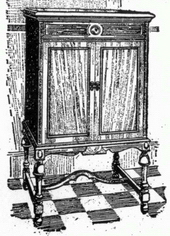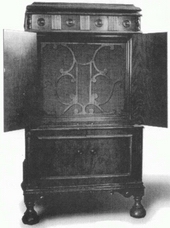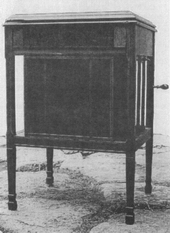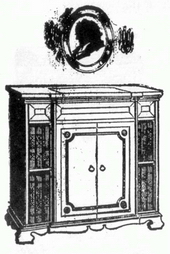Canadian Antique Phonograph Society
showing a Credenza model Orthophonic Victrola.

My Orthophonic Victrola isn't in "Look For the Dog". That’s what we heard from many of the CAPS members we spoke with when we began seriously studying these late Victors a few years back. Since most collections have one or two if any Orthophonics, this has been a mild curiosity to each of them, but as the list of Canadian only names and model numbers grew, we were astonished at the range of unpublished (and yet to be discovered) Victors made here.
In the hope of uncovering more models, and with the warmest thanks to the members who helped along the way, here are the "new" Victors.
During the first season (1925/26) the Victor Talking Machine Company of Canada produced models identical to the Camden New Jersey line. Only the plain announcement on the record label of electrical recording early in 1925 (while in the US Victor kept it quiet until the fall) foreshadowed the coming parting of ways.
In 1927, models known only by numbers south of the boarder were given names like the "Paloma", called the VV 4-7 in the States and the popular "Barona", known there as the VV 4-40.




Also this year appeared the first cabinet design we know of which has no U.S. counterpart. The "Alvara" (reg. 1927) evidently sold well. Behind the doors is a medium sized horn with record storage on three sides.


From 1928 comes the VV 4-70 (finally numbering them as the US company did) which survives in numbers suggesting it was popular. We haven't yet seen a record sleeve illustration of this one, but the photo shows its exuberant design. With applied half-spindles, reeding, bosses and moldings, pendant door pulls and a flowing grill to top it off, this design is a favorite. Since the space behind the doors is given entirely to the horn (record storage below) is sounds good too.
From 1929 comes the small VV 4-30 with its simple table-like frame, open record storage and doorless design it was likely the economy model in a slow sales year.
Shown are two sleeve illustrations of Canadian models we have yet to see. They are not identified by name or number, though the first is like a 4-3 (consolette) dressed up for the fancy 1928 model year, and the second is just like the American 8-35 (1928/29) except for the curvaceous design of the feet.
If any readers can help in identifying the rest of these by means of old ads, surviving machines and such, this would be most welcome.

